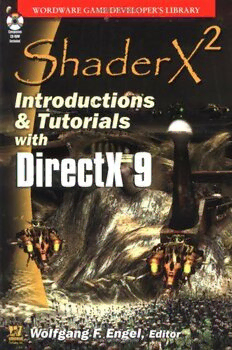
ShaderX2: Introductions and Tutorials with DirectX 9.0 PDF
393 Pages·2003·5.807 MB·English
Most books are stored in the elastic cloud where traffic is expensive. For this reason, we have a limit on daily download.
Preview ShaderX2: Introductions and Tutorials with DirectX 9.0
Description:
ShaderX2 is broken in to two volumes, with this volume intended as an introduction to shader related topics to prepare the reader for the other volume, or for other shader books. It fills that role fairly well, though it does have a few shortcomings that keep it from being a great book.
The book starts off with an extensive, well-written introduction to HLSL that most beginners to the language will find quite helpful. This is followed by a handy introduction to Shader Model 3.0, which explains the changes that have been made since 2.0, and the practical applications of these changes and additions.
The next several chapters are devoted to implementing "foundational" techniques using shaders. The first covers several lighting and shading techniques, providing sample shader implementations in HLSL and assembly. Most of the shaders come in multiple versions for the various shader models, which is useful for supporting these techniques on a wide range of platforms, as well as in understanding the capability differences between each model.
The next chapter covers five different fog effects using HLSL shaders. Then there are two chapters on shadows, one on shadow mapping and the other on shadow volumes. The latter weighs in at over 80 pages, providing in-depth coverage of the theory behind the technique.
Next up is a tutorial for using the shader development environment RenderMonkey. The usefulness of this chapter is marred by the fact that the current version of RenderMonkey has undergone some interface changes such that the text is now out of synch with the tool, making it a bit more difficult to follow along. Still, if you can work through this, the chapter will help you quickly get up and running with RenderMonkey.
The last chapter of the book is about creating shader-friendly models. This chapter seems out of place since it's written more for artists than programmers (who are clearly the audience for the rest of the book), and the chapter is too brief and vague to be of much value.
If you're new to shaders and HLSL, you'll likely find this book useful, though it's a little expensive for a small book (I imagine the color plates contribute to this). If the shadow and fog chapters had been moved to the other ShaderX2 book, and the final chapter had been dropped, I think that they could have reduced the price considerably and made the book more focused, turning it into a great value. As it is, though, it's still a good book that many people will benefit from.
See more
The list of books you might like
Most books are stored in the elastic cloud where traffic is expensive. For this reason, we have a limit on daily download.
